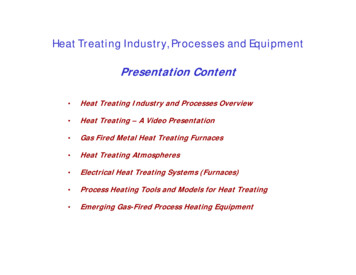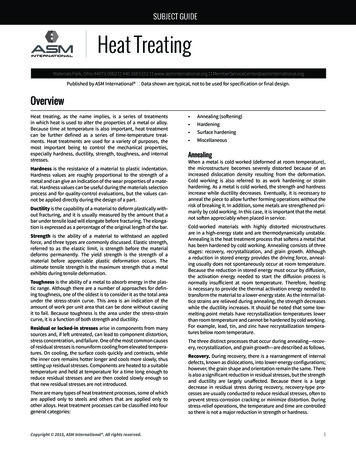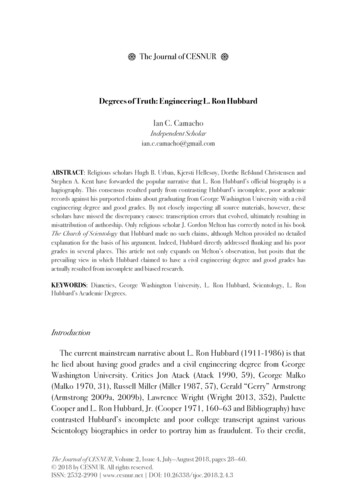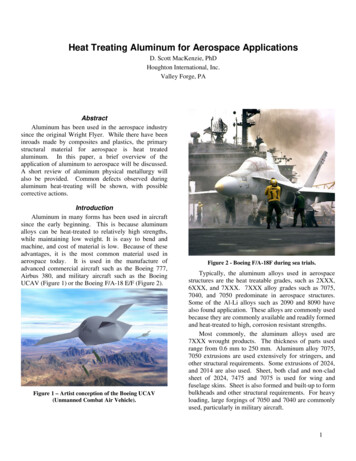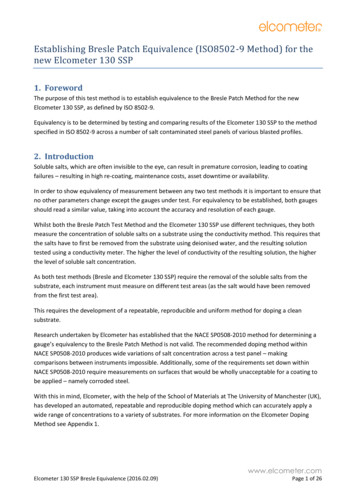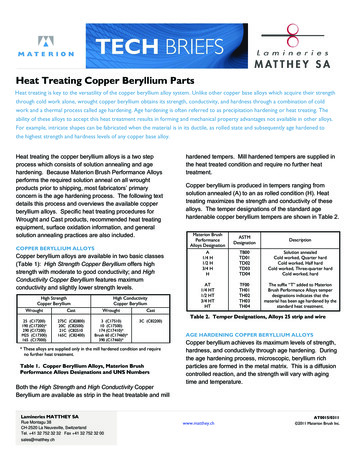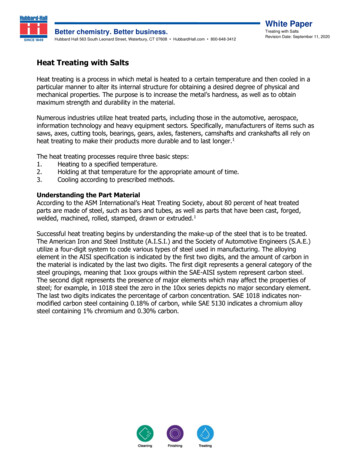
Transcription
White PaperBetter chemistry. Better business.Hubbard Hall 563 South Leonard Street, Waterbury, CT 07608 HubbardHall.com 800-648-3412Treating with SaltsRevision Date: September 11, 2020Heat Treating with SaltsHeat treating is a process in which metal is heated to a certain temperature and then cooled in aparticular manner to alter its internal structure for obtaining a desired degree of physical andmechanical properties. The purpose is to increase the metal’s hardness, as well as to obtainmaximum strength and durability in the material.Numerous industries utilize heat treated parts, including those in the automotive, aerospace,information technology and heavy equipment sectors. Specifically, manufacturers of items such assaws, axes, cutting tools, bearings, gears, axles, fasteners, camshafts and crankshafts all rely onheat treating to make their products more durable and to last longer.1The heat treating processes require three basic steps:1.Heating to a specified temperature.2.Holding at that temperature for the appropriate amount of time.3.Cooling according to prescribed methods.Understanding the Part MaterialAccording to the ASM International’s Heat Treating Society, about 80 percent of heat treatedparts are made of steel, such as bars and tubes, as well as parts that have been cast, forged,welded, machined, rolled, stamped, drawn or extruded.1Successful heat treating begins by understanding the make-up of the steel that is to be treated.The American Iron and Steel Institute (A.I.S.I.) and the Society of Automotive Engineers (S.A.E.)utilize a four-digit system to code various types of steel used in manufacturing. The alloyingelement in the AISI specification is indicated by the first two digits, and the amount of carbon inthe material is indicated by the last two digits. The first digit represents a general category of thesteel groupings, meaning that 1xxx groups within the SAE-AISI system represent carbon steel.The second digit represents the presence of major elements which may affect the properties ofsteel; for example, in 1018 steel the zero in the 10xx series depicts no major secondary element.The last two digits indicates the percentage of carbon concentration. SAE 1018 indicates nonmodified carbon steel containing 0.18% of carbon, while SAE 5130 indicates a chromium alloysteel containing 1% chromium and 0.30% carbon.
White PaperBetter chemistry. Better business.Hubbard Hall 563 South Leonard Street, Waterbury, CT 07608 HubbardHall.com 800-648-3412SAE designationType1xxxCarbon steels2xxxNickel steels3xxxNickel-chromium steels4xxxMolybdenum steels5xxxChromium steels6xxxChromium-vanadium steels7xxxTungsten steels8xxxNickel-chromium-vanadium steels9xxxSilicon-manganese steelsTreating with SaltsRevision Date: September 11, 2020Carbon steel has a main alloying constituent of carbon in the range of 0.12% to 2.0%. Plaincarbon steel is usually iron with less than 1% carbon, plus small amounts of manganese,phosphorous, sulfur and silicon. Carbon steel is broken down into four classes based on carboncontent: Low Carbon Steel: up to 0.21% carbon content Medium Carbon Steel: 0.3 - 0.6% carbon content High Carbon Steel: 0.6 - 1.0% carbon content Ultra-High Carbon Steel: 1.25 - 2.0% carbon contentThe Austempering and Quenching ProcessAustempering is a heat treatment that is applied to ferrous metals and is defined by both theprocess and the resultant microstructure of the work. In steel, it produces a bainite (or a platelike) microstructure, which is made up of packets of parallel plates in the morphological packet.
White PaperBetter chemistry. Better business.Hubbard Hall 563 South Leonard Street, Waterbury, CT 07608 HubbardHall.com 800-648-3412Treating with SaltsRevision Date: September 11, 2020When heated to temperatures below 730 C, the pure metal iron has a body-centered cubicstructure; if heated above this temperature the structure will change to a face-centered cubic. Oncooling, the change is reversed and a body-centered cubic structure is once more formed. Theimportance of this reversible transformation lies in the fact that up to 2.0% carbon can dissolve ina face-centered cubic, forming what is known as a “solid solution.” While in a body-centered cubiciron state, no more than 0.02% carbon can be dissolved this way. The solid solution formed whenthe carbon atoms are absorbed into the face-centered cubic structure of iron is called austenite.When quenched, carbon is precipitated from austenite not in the form of elemental carbon(graphite), but as the compound iron carbide Fe3C, usually call cementite. Like most othermetallic carbides, this substance, is usually very hard; as the amount of carbon increases, thehardness of the cooled steel will also increase.The temperature of the quench tank is set so that the material is rapidly cooled down through thepearlite phase and quenched at a temperature that falls within the bainite region, but stayingabove the marentsitic phase. The austempered bainite microstructure of the work imparts highductility, impact strength and wear resistance for a given hardness; a rifle bolt was one of thefirst uses for this process.The salt quench also provides low distortion of work with repeatable dimensional response. Itincreases fatigue strength and is resistant to hydrogen and environmental embrittlement.
White PaperBetter chemistry. Better business.Hubbard Hall 563 South Leonard Street, Waterbury, CT 07608 HubbardHall.com 800-648-3412Treating with SaltsRevision Date: September 11, 2020Heat Treat with Salt BathsSalt bath heat treatment is a heat treatment process comprising an immersion of the treated partinto a molten salt, or salts mixture.2 There are numerous benefits of heat treatment in salt baths,the most prevalent is that they provide faster heating. A work part immersed into a molten salt isheated by heat transferred by conduction (combined with convection) through the liquid media(salt bath).2 The heat transfer rate in a liquid media is much greater than that in other heatingmechanisms, such as radiation or convection through a gas.2Using salt baths also helps with a controlled cooling conditions during quenching. In conventionalquenching operation, either water or oil are used as the quenching media and the high coolingrate provided by water/oil may cause cracks and distortions. Cooling in molten salt is slower andstops at lower temperature.2Salt baths also provide low surface oxidation and decarburization, as the contact of the hot workpart with the atmosphere is minimized when the part is treated in the salt bath.2 There areadditional advantages to salt heat treat: Wide operating temperatures: 300 F -1100 F Most of the heat is extracted during quenching by convection at a uniform rate. Salt gives buoyancy to the work being processed to hold work distortion to aminimum. Quench severity can be controlled or manipulated by a greater degree by varyingtemperature, agitation and water content of the salt. Excellent thermal and chemical stability of the salt means that the only replenishmentrequired is due to drag-out losses. Nonflammable salt poses no fire hazard. Salt is easily removed with water after quenching.Want to Learn More?Hubbard-Hall has a lot of information for you to learn more about neutral salts, quenching andtempering salts, rubber curing salts and solution heat treating/annealing of aluminum anddescaling salts.Neutral Salts: designed to provide excellent fluidity and great stability, Hubbard-Hall’s neutralheat treatment salts are formulated with a balanced mixture of chlorides. The Neutral Saltshighlighted in this section include only 1 non-barium product (neutral salt B). Selection of neutralsalts is generally based on operating range.Quenching and Tempering Salts: this line of heat treatment salts is composed of nitrate-nitritesalts for use as steel tempering or quenching media. All are completely water soluble, easilywashed and have similar high-transfer rates and heat capacity.Solution Heat Treating/Annealing of Aluminum: molten heat treatment salts provide a highdegree of temperature uniformity required for the satisfactory heat treatment of aluminum alloys.Hubbard-Hall’s aluminum heat treatment salts are free-flowing and high purity products.
White PaperBetter chemistry. Better business.Hubbard Hall 563 South Leonard Street, Waterbury, CT 07608 HubbardHall.com 800-648-3412Treating with SaltsRevision Date: September 11, 2020Descaling Salts: molten descaling salts can be used to remove oxide scales from both ferrous andnon-ferrous metals. Molten Descaling Salts have the ability to produce clean, scale-free surfaceswithout base metal loss, pitting or etching.Rubber Curing Salts: rubber curing heat treatment salts are high purity, eutectic mixture ofnitrate and nitrite salts. They are formulated specifically for curing extruded rubber profiles at thelowest possible temperature ranges. All chemicals used in these rubber curing salts are watersoluble and do not form any insolubles. Therefore, the solidified salt is easily removed from thesurface in a hot water spray rinsing station at the end of the trough just after emerging from thesalt trough.References:1.ASM International; d salt bath heat treatmentOur people. Your problem solvers.For questions or comments on this information please call us at1-800-648-3412 or techservice@hubbardhall.com
Heat Treat with Salt Baths Salt bath heat treatment is a heat treatment process comprising an immersion of the treated part into a molten salt, or salts mixture.2 There are numerous benefits of heat treatment in salt baths, the most prevalent is that they provide faster heating. A work part immersed into a molten salt is

